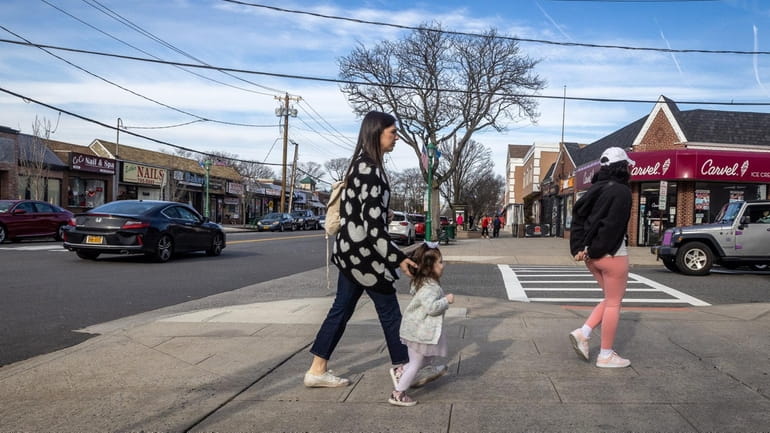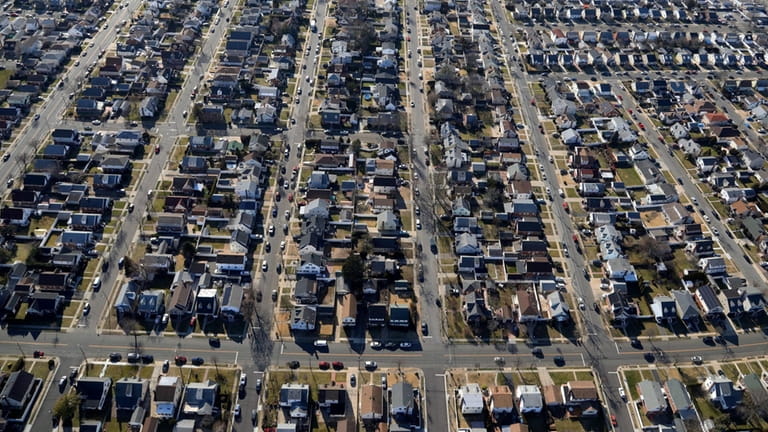Long Island towns, cities lose population, Census Bureau says, with Oyster Bay's drop the largest

Massapequa Park, one of the villages that has lost population, according to new estimates from the U.S. Census Bureau. Credit: Newsday/J. Conrad Williams Jr.
Populations in Long Island's towns and cities shrank, with the exception of three East End towns that saw very small gains, according to 2022 U.S. Census Bureau estimates released Thursday, and experts say the trend may be linked to the Island's housing options.
While Oyster Bay Town had the biggest percent decrease in population, Islip town was close behind, the bureau said.
The Island population declines are "something that policymakers should be paying attention to … It has to do with the future prosperity of the region and the metro area as a whole. It does raise concerns about workforce and the ability to meet economic growth," said Marcel Negret, senior planner with the Regional Plan Association, an independent nonprofit civic organization. The group seeks to improve the economic health, environmental resiliency, and quality of life of the metropolitan area.
Negret added, "One of the things that perhaps explains a lot of these trends is the lack of housing options and also a mismatch between the type of housing that's being created and the changes in the household composition."
The estimates for towns and villages comes after population estimates for the counties, released in March, which showed that Nassau and Suffolk together lost just over 15,000 people between July 1, 2021, and July 1, 2022. The data released Thursday estimates how those population losses are distributed among the counties' towns and villages.
Negret pointed to a building permit survey released earlier this month by the Census Bureau. Between 2012 and 2022, permits on Long Island were overwhelmingly issued for single-family units versus multifamily units, the survey showed: 17,907 single-family units compared with 5,800 units in multifamily buildings of five units or more. There were an additional 360 units in "middle-unit" dwellings of between two and four units, he said.
"The few units that are being created on Long Island are single-family" homes, Negret said. "That is not in alignment with an aging population and households with fewer people and children." He added, "People need places they can afford and that meet their needs." If those needs aren't being provided for, he said, "they will be forces for people to leave and look for opportunities elsewhere."
One expert said a reason for the fluctuations may be the pandemic-related difficulties in capturing exact population estimates in "group quarters" facilities such as dormitories, nursing homes and prisons.
The difference in estimated population changes between municipalities in the same county "can only be caused by differences in the change in housing units (mostly new developments) and by group quarters populations," Jan Vink, researcher with Cornell University's Program on Applied Demographics, said in an email.
Vink cautioned, however that there have been significant fluctuations in the “group quarters populations,” which are made up of those in student dorms, prisons and nursing homes, in the last few years due to COVID. “These fluctuations will impact some local communities,” he said. “If you see some weird patterns in the population, then group quarters are probably to blame."
According to the 2022 Vintage Population Estimates, Oyster Bay Town had a 0.69% drop, or 2,065 people, in its population between 2021 and 2022, going from 300,007 to 297,942. The Town of Islip had the next largest percent drop in population — 0.68%, or 2,300 people — between 2021 and 2022, when its population was estimated at 337,922, down from 340,222.
Hempstead Town, the Island's and the state's largest town, saw its population drop 0.46%, or by 3,669 people, going from 790,923 in 2021 to 787,254 in 2022, according to the estimates.
The East End towns of Southold, whose 2022 population was estimated at 23,912, a gain of 63 people; Southampton, population 69,490, up 160 people; and East Hampton, population 28,607, up 61 people, saw modest gains of 0.26%, 0.23% and 0.21% respectively.
Among villages with populations greater than 10,000 people, Floral Park, Massapequa Park, Lynbrook, Mineola, and Freeport had the largest percent declines in population. Floral Park's population dropped by 0.87%, or 139 people; Massapequa Park by 0.86% or 147 people; Lynbrook, 0.84%, or 171 people; Mineola, 0.82%, or 175 people; and Freeport, 0.78% or 346 people. Of the five, Freeport had the largest population overall, at 43,886 in 2022.
Hempstead Village, the most populous village in the state, saw a 0.61% drop in population, with an estimated 58,331 population in 2022, down 360 people from its 2021 estimate of 58,691.
Estimates were not provided for unincorporated hamlets.
New York City had the largest decline in population between 2021 and 2022, but the decline was far less than the prior year, according to the Census Bureau. New York lost 123,104 people between July 1, 2021 and July 1, 2022, for a total estimated population in 2022 of 8.3 million. Between 2020 and 2021, the city lost 281,646, the bureau said.
Populations in Long Island's towns and cities shrank, with the exception of three East End towns that saw very small gains, according to 2022 U.S. Census Bureau estimates released Thursday, and experts say the trend may be linked to the Island's housing options.
While Oyster Bay Town had the biggest percent decrease in population, Islip town was close behind, the bureau said.
The Island population declines are "something that policymakers should be paying attention to … It has to do with the future prosperity of the region and the metro area as a whole. It does raise concerns about workforce and the ability to meet economic growth," said Marcel Negret, senior planner with the Regional Plan Association, an independent nonprofit civic organization. The group seeks to improve the economic health, environmental resiliency, and quality of life of the metropolitan area.
Negret added, "One of the things that perhaps explains a lot of these trends is the lack of housing options and also a mismatch between the type of housing that's being created and the changes in the household composition."
The estimates for towns and villages comes after population estimates for the counties, released in March, which showed that Nassau and Suffolk together lost just over 15,000 people between July 1, 2021, and July 1, 2022. The data released Thursday estimates how those population losses are distributed among the counties' towns and villages.

A commuter waits for a train at the LIRR station in Freeport, one of the villages that has lost population, according to the U.S. Census Bureau. Credit: Newsday/J. Conrad Williams Jr.
Negret pointed to a building permit survey released earlier this month by the Census Bureau. Between 2012 and 2022, permits on Long Island were overwhelmingly issued for single-family units versus multifamily units, the survey showed: 17,907 single-family units compared with 5,800 units in multifamily buildings of five units or more. There were an additional 360 units in "middle-unit" dwellings of between two and four units, he said.
"The few units that are being created on Long Island are single-family" homes, Negret said. "That is not in alignment with an aging population and households with fewer people and children." He added, "People need places they can afford and that meet their needs." If those needs aren't being provided for, he said, "they will be forces for people to leave and look for opportunities elsewhere."
One expert said a reason for the fluctuations may be the pandemic-related difficulties in capturing exact population estimates in "group quarters" facilities such as dormitories, nursing homes and prisons.
The difference in estimated population changes between municipalities in the same county "can only be caused by differences in the change in housing units (mostly new developments) and by group quarters populations," Jan Vink, researcher with Cornell University's Program on Applied Demographics, said in an email.
Vink cautioned, however that there have been significant fluctuations in the “group quarters populations,” which are made up of those in student dorms, prisons and nursing homes, in the last few years due to COVID. “These fluctuations will impact some local communities,” he said. “If you see some weird patterns in the population, then group quarters are probably to blame."
According to the 2022 Vintage Population Estimates, Oyster Bay Town had a 0.69% drop, or 2,065 people, in its population between 2021 and 2022, going from 300,007 to 297,942. The Town of Islip had the next largest percent drop in population — 0.68%, or 2,300 people — between 2021 and 2022, when its population was estimated at 337,922, down from 340,222.
Hempstead Town, the Island's and the state's largest town, saw its population drop 0.46%, or by 3,669 people, going from 790,923 in 2021 to 787,254 in 2022, according to the estimates.
The East End towns of Southold, whose 2022 population was estimated at 23,912, a gain of 63 people; Southampton, population 69,490, up 160 people; and East Hampton, population 28,607, up 61 people, saw modest gains of 0.26%, 0.23% and 0.21% respectively.

A view of Mineola, one of the villages that has lost population, according to the U.S. Census Bureau. Credit: Newsday/John Keating
Among villages with populations greater than 10,000 people, Floral Park, Massapequa Park, Lynbrook, Mineola, and Freeport had the largest percent declines in population. Floral Park's population dropped by 0.87%, or 139 people; Massapequa Park by 0.86% or 147 people; Lynbrook, 0.84%, or 171 people; Mineola, 0.82%, or 175 people; and Freeport, 0.78% or 346 people. Of the five, Freeport had the largest population overall, at 43,886 in 2022.
Hempstead Village, the most populous village in the state, saw a 0.61% drop in population, with an estimated 58,331 population in 2022, down 360 people from its 2021 estimate of 58,691.
Estimates were not provided for unincorporated hamlets.
New York City had the largest decline in population between 2021 and 2022, but the decline was far less than the prior year, according to the Census Bureau. New York lost 123,104 people between July 1, 2021 and July 1, 2022, for a total estimated population in 2022 of 8.3 million. Between 2020 and 2021, the city lost 281,646, the bureau said.
